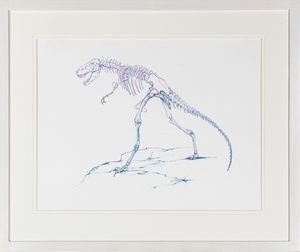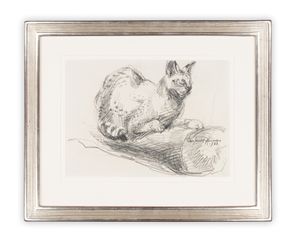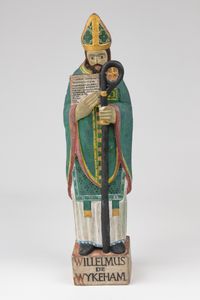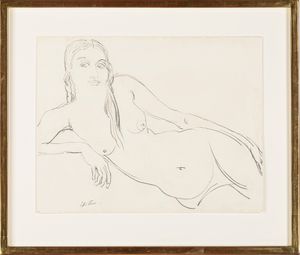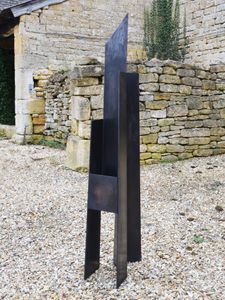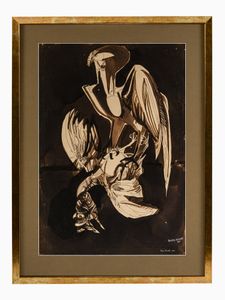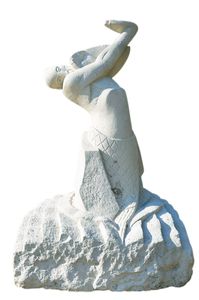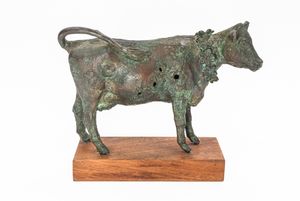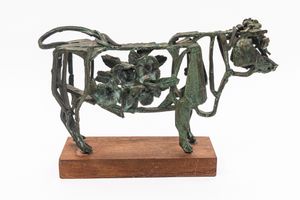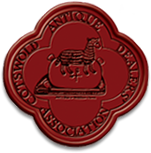Attributed to the Workshop of Eric Gill 1882-1940
A plaster cast plaque of letters from the Trajan Column
Attributed to the Workshop of Eric Gill 1882-1940
A plaster cast plaque of letters from the Trajan Column
Circa 1919
Stock Number: 14313/MB
Height
58.50cm
[23.03 inches]
Width 57.50cm [22.64 inches]
Depth 3.50cm [1.38 inches]
Width 57.50cm [22.64 inches]
Depth 3.50cm [1.38 inches]
Price on application
Expertise kindly provided by Ewan Clayton
A similar version is held in the Victoria and Albert Museum under: object no. REPRO.6036
A plaster cast plaque of letters from the Trajan Column
This plaster cast contains a full set of Roman Capitals as they appear on Trajan's Column in Rome. Note that there is no J, K, W or Z on the column's inscription, and they are lacking here also.
The column itself was dedicated in May 113 CE to celebrate the achievements of the Emperor Trajan (born 53- died 117 CE) during the Dacian campaigns of 101-2 and 105-6 CE. In the plan drawn up for Trajan's forum by its architect Apollodorus of Damascus the column was erected in the middle of a small courtyard whose sides were formed by the great Aula and two flanking two storey libraries: one for Greek literature and the other for Latin works. The final side would eventually house a Temple to honour the deified Emperor.
The sculpted scenes on column are constructed in the form of a scroll unrolled from the bottom and winding up to the top. The inscription is contained on a small tablet at the base of the column reminiscent of the ivory tablet that would hang of the end of a scroll explaining its content.
The inscription at the base of the column has been acclaimed as one of the high points in Roman letter carving. Moulds were first made of the entire column in 1861 when the French Emperor Napoleon III wanted to erect a replica in Paris. Taking moulds of the base of the column and its inscription seems to have been an afterthought. A cast was made by a M. Maitre in 1872 at a cost of 5,000 francs. Copies of all the casts including the base were obtained by the Victoria and Albert Museum in London and installed there in its plaster court around 1874. The museum sold copies of the inscription for £7. These copies were of the intact inscription not simply an alphabet, in this respect our plaque is unique, only matched by one other copy held in the V & A Museum, it is possible that this plaque comes from the same source.
The plaster tablet seems to have been deliberately created as a record of the column's alphabet, probably for study or teaching purposes and perhaps by Gill himself who is known to have experimented with plaster casting. The spacing of the letters on this plaque is uneven hinting at technical constraints in making the mould and indicating that an overall aesthetic effect is not being aimed for, rather this is intended as a practical record of letter shape, proportion and size.
As Edward Catich showed in his book The Origins of the Serif (1968) the Roman method for making this and similar inscriptions was for a craftsperson to paint the letters directly with a broad brush on to the stonework, every letter is thus a unique statement, an effect enhanced in this case because in laying out the original inscription the craftsman compensated for the distortions of perspective when viewing the tablet from ground level. The letters actually increase in height as the rise away from us.
Through careful measurement and comparison with drawings made from rubbings of the original inscription in the Roman forum by Edward Catich in 1930, we can track the letters on this plaque back to their original examples.
Catich established a system for identifying individual letters. Each letter is given a two-figure number. The first figure represents the row they come from in the inscription and the second letter is the instance of that letter along the line, so the number 34 next to A means that letter can be found in line three and is the fourth example of A along that line.
Following Catich's system for numbering them we can thus identify the letters in this cast as: A:34, B:41, C: 51? D:53, E:51, F:31, G:32, I:31, L:52, M:11, N:11, O:41, P:12, Q:11, R:41, S:11, T:11, V:12, X:41.
The back of this panel has a roughly painted note on it that reads 'TROGEN ALPH T.C'. The looped R and G with straight descender are reminiscent of Gill's hand and the deliberate misspelling of Trajan sounds like the kind of 'in joke' or pun that Gill enjoyed making i.e. this is the alphabet that had got inside the 'city' and would eventually lead to the fall of the old Victorian order of lettering.
If this plaque does originate from Gill's studio then its use could have included the instruction of apprentices, but more likely it would have been used in the classes he taught in masonry and sign writing at the Central School of Arts and Crafts (1906-1910) and The Paddington Institute (1905-1910). It is light, compact and portable. It could also have been useful for the detailed study he made of the inscription prior to drawing up an alphabet based upon the Trajan Column for Edward Johnston's portfolio 'Manuscript and Inscriptional Letters' issued by John Hogg in 1909. Some of Gill's inscriptional work for this portfolio could be obtained in plaster cast form from C. Smith and Sons, Kentish Town.
A similar version is held in the Victoria and Albert Museum under: object no. REPRO.6036
A plaster cast plaque of letters from the Trajan Column
This plaster cast contains a full set of Roman Capitals as they appear on Trajan's Column in Rome. Note that there is no J, K, W or Z on the column's inscription, and they are lacking here also.
The column itself was dedicated in May 113 CE to celebrate the achievements of the Emperor Trajan (born 53- died 117 CE) during the Dacian campaigns of 101-2 and 105-6 CE. In the plan drawn up for Trajan's forum by its architect Apollodorus of Damascus the column was erected in the middle of a small courtyard whose sides were formed by the great Aula and two flanking two storey libraries: one for Greek literature and the other for Latin works. The final side would eventually house a Temple to honour the deified Emperor.
The sculpted scenes on column are constructed in the form of a scroll unrolled from the bottom and winding up to the top. The inscription is contained on a small tablet at the base of the column reminiscent of the ivory tablet that would hang of the end of a scroll explaining its content.
The inscription at the base of the column has been acclaimed as one of the high points in Roman letter carving. Moulds were first made of the entire column in 1861 when the French Emperor Napoleon III wanted to erect a replica in Paris. Taking moulds of the base of the column and its inscription seems to have been an afterthought. A cast was made by a M. Maitre in 1872 at a cost of 5,000 francs. Copies of all the casts including the base were obtained by the Victoria and Albert Museum in London and installed there in its plaster court around 1874. The museum sold copies of the inscription for £7. These copies were of the intact inscription not simply an alphabet, in this respect our plaque is unique, only matched by one other copy held in the V & A Museum, it is possible that this plaque comes from the same source.
The plaster tablet seems to have been deliberately created as a record of the column's alphabet, probably for study or teaching purposes and perhaps by Gill himself who is known to have experimented with plaster casting. The spacing of the letters on this plaque is uneven hinting at technical constraints in making the mould and indicating that an overall aesthetic effect is not being aimed for, rather this is intended as a practical record of letter shape, proportion and size.
As Edward Catich showed in his book The Origins of the Serif (1968) the Roman method for making this and similar inscriptions was for a craftsperson to paint the letters directly with a broad brush on to the stonework, every letter is thus a unique statement, an effect enhanced in this case because in laying out the original inscription the craftsman compensated for the distortions of perspective when viewing the tablet from ground level. The letters actually increase in height as the rise away from us.
Through careful measurement and comparison with drawings made from rubbings of the original inscription in the Roman forum by Edward Catich in 1930, we can track the letters on this plaque back to their original examples.
Catich established a system for identifying individual letters. Each letter is given a two-figure number. The first figure represents the row they come from in the inscription and the second letter is the instance of that letter along the line, so the number 34 next to A means that letter can be found in line three and is the fourth example of A along that line.
Following Catich's system for numbering them we can thus identify the letters in this cast as: A:34, B:41, C: 51? D:53, E:51, F:31, G:32, I:31, L:52, M:11, N:11, O:41, P:12, Q:11, R:41, S:11, T:11, V:12, X:41.
The back of this panel has a roughly painted note on it that reads 'TROGEN ALPH T.C'. The looped R and G with straight descender are reminiscent of Gill's hand and the deliberate misspelling of Trajan sounds like the kind of 'in joke' or pun that Gill enjoyed making i.e. this is the alphabet that had got inside the 'city' and would eventually lead to the fall of the old Victorian order of lettering.
If this plaque does originate from Gill's studio then its use could have included the instruction of apprentices, but more likely it would have been used in the classes he taught in masonry and sign writing at the Central School of Arts and Crafts (1906-1910) and The Paddington Institute (1905-1910). It is light, compact and portable. It could also have been useful for the detailed study he made of the inscription prior to drawing up an alphabet based upon the Trajan Column for Edward Johnston's portfolio 'Manuscript and Inscriptional Letters' issued by John Hogg in 1909. Some of Gill's inscriptional work for this portfolio could be obtained in plaster cast form from C. Smith and Sons, Kentish Town.














